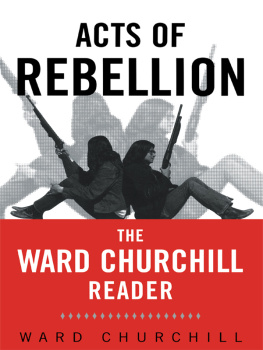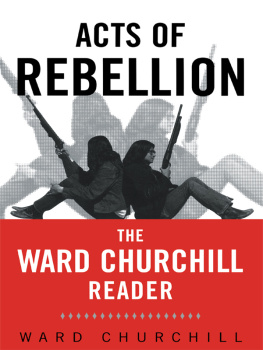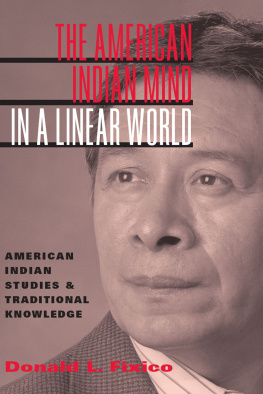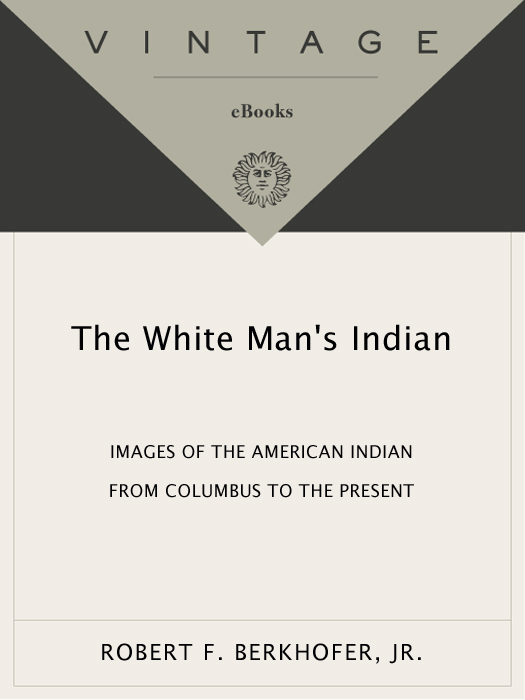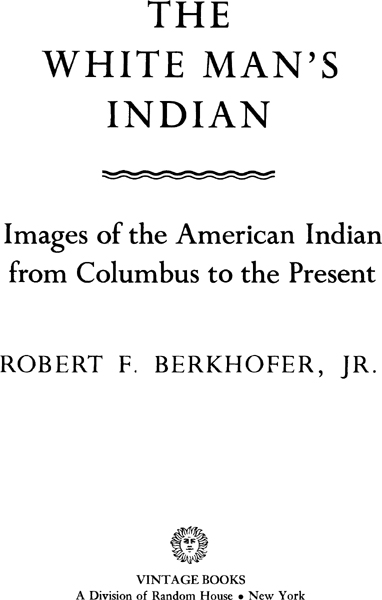Copyright 1978 by Robert F. Berkhofer, Jr.
All rights reserved under International and Pan-American Copyright Conventions. Published in the United States by Random House, Inc., New York, and in Canada by Random House of Canada Limited, Toronto. Originally published by Alfred A. Knopf, Inc., in March 1978.
1. Indians of North AmericaPublic opinion.
2. Public opinionUnited States. 3. United States
CivilizationIndian influences. I. Title.
E98.P99B47 1979 301.15439700497 78-11047
For Mary E. Young
Contents
PART ONE The Idea of the Indian:
Invention and Perpetuation
PART TWO From Religion to Anthropology:
The Genealogy of the Scientific Image of the Indian
PART THREE Imagery in Literature, Art, and Philosophy:
The Indian in White Imagination and Ideology
PART FOUR Imagery and White Policy:
The Indian as Justification and Rationale
Acknowledgments
T HOSE FRIENDS who have commented upon some or all of this book as manuscript deserve to be thanked as much as the authors I have cited in the footnotes. They have saved me from embarrassing slips in fields and topics that are outside my training or knowledge. If I have at times forgotten or twisted their advice in my eagerness to present a thesis, I hope they will forgive me. The work is dedicated to Mary E. Young for her understanding criticism of this as well as others of my books. James Axtell, Robert Bieder, Paul Conkin, Charles Gibson, Lee Goerner, John King, Alfonso Ortiz, George Stocking, George Mosse, and Stephen Tonsor all have improved this volume in small and large ways. My wife, Genevieve, performed the important function of listener as well as editor. James Hennessey, Raymond Boryczka, and Michael Pfeiffer helped as research assistants. Angus Cameron waited patiently for the author to finish the manuscript and had faith the wait was worthwhile.
Portions of the manuscript or its ideas were discussed with the fellows at the Center for the History of the American Indian at the Newberry Library over several years. I owe thanks to James Tracy for the opportunity to present the overall thesis for criticism at a colloquium on the Noble Savage at the University of Minnesota. To William Sturtevant and Wilcomb Washburn, respectively editor-in-chief of the Handbook of North American Indians, and editor of the volume on Indian-White relations to be issued by the Smithsonian Institution, I owe appreciation not only for reading my original drafts of some of the manuscript but also for permission to use some of the material originally commissioned for the Handbook. Parts Two and Three and half of Part One are greatly expanded versions of the article on White conceptions of the Indian that will appear in the Indian-White relations volume.
Today an author must not only rely on friends for criticism but also on institutions for support. The Folger Library and the National Endowment for the Humanities provided fellowships for research and writing, and the Universities of Wisconsin and Michigan gave grants-in-aid for research assistance.
Preface
W HITE INTEREST in the American Indian surges and ebbs with the tides of history. While White fascination with things Indian never entirely fades, it has easily discernible high and low points. Recently, Americans went through another period of great interest. Real and imitation Indian jewelry festooned the arms and necks of White American men and women, while bedspreads, towels, and tablecloths decorated with supposed Indian motifs adorned their homes. Books by and about Indians made the best-seller lists, and Indian heroes appeared upon movie and television screens. Authentic and fake Indians emerged in mass-media advertisements to sell everything from breakfast cereals to ecology. Newspapers and magazines carried exposs of the Indians plight, and Indian leaders gained attention for the problems of their people through Red Power slogans and tactics. Doctoral students in American literature and history as well as anthropology produced increasing numbers of dissertations upon the image and reality of Indian life in the present and the past, while history and English departments hastily instituted courses in Indian history and literature to bolster their declining enrollments through capitalizing upon the latest interest of college students.
Just as surely as in the past, this fascination with things Indian will recede. Clearance sales of Indian jewelry and household furnishings have already come and gone. Books about Indians gather on the remainder tables. Red Power slogans have lost their power to excite middle-class liberals to larger contributions. Indian leaders search for new ways to capture the attention of the American public as its interest in political change disappears with the altered economic outlook in the United States. The appearance of numerous doctoral dissertations and monographs on a topic usually marks the end, not the high point, of a fad.
This book seeks not so much to explain the fluctuating White interest in the Indian as to present the implications of the ideas and imagery used by Whites to understand the peoples they call Indians. If history is a series of questions put to the past by the present, then one of the goals of this book is to query why we think about the Indian the way we do today. Through examining how the White image of the Indian developed over time, I seek to illumine contemporary understanding of Indians as people. By suggesting the continuity as well as the changing uses of the idea and imagery of the Indian, this book also hopes to influence our future understanding of the first Americans. If the last goal seems too weighty for an essay, then this book at least offers perspective upon the many other books that have issued forth so profusely in recent times. Such perspective comes from the books continuing focus upon how present assumptions shape the study of the Indian of the past as much as how todays ideas about the first Americans derive from yesteryears. Indeed, the chief intellectual object of this book is to exemplify as well as to explicate the constant interaction between the past and present in molding current understanding of the Indian and therefore in turn the changing comprehension of past understandings as well. In other words, I try to treat current conceptions of the Indian in the same relativistic manner as I do those of the past.
In fact, the immediate stimulus for my own volume comes precisely from the stances on these very points by those many other books and articles flowing so swiftly from the presses today. The initial draft of parts of this book began as an assignment for the new multi-volume Handbook of North American Indians to be published by the Smithsonian Institution. At the request of Wilcomb Washburn, the editor of the volume on the history of Indian-White relations, I prepared a long article on White conceptions of the Indian from Columbus to the present. In the course of surveying the voluminous secondary literature from the several disciplines that I considered relevant to the topic, I was constantly struck by how often scholars seemed oblivious of research germane to their topics in other disciplines or how frequently they presented conclusions and themes about a historic period without being aware of similar patterns holding for another era.


